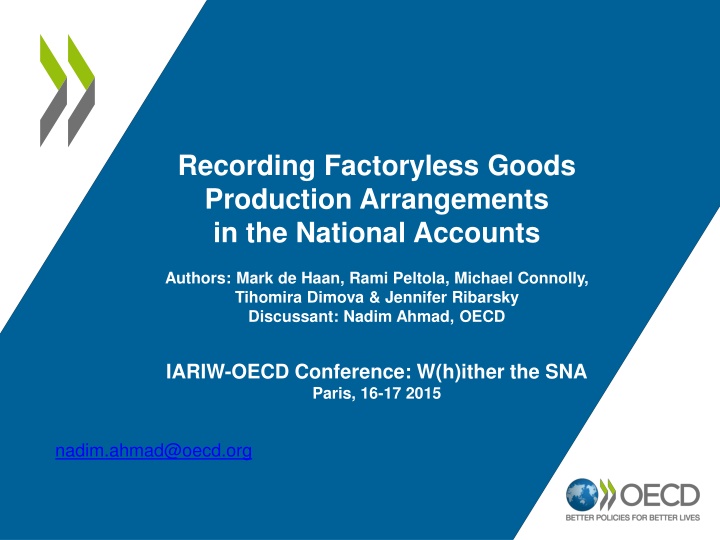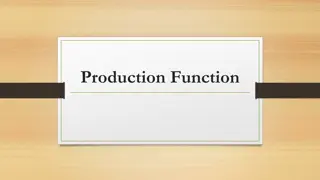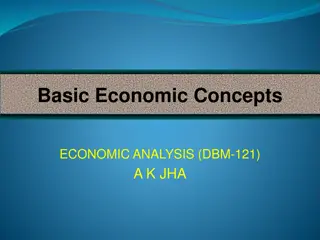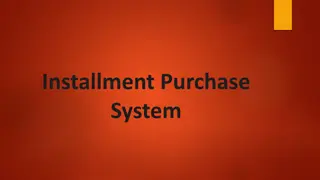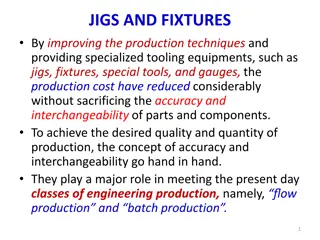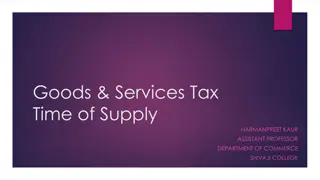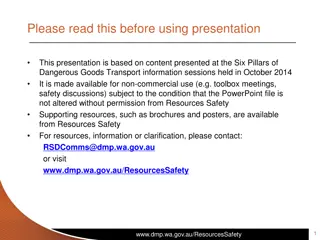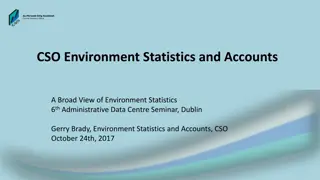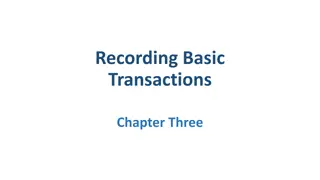Recording Factoryless Goods Production Arrangements in National Accounts
Authors Mark de Haan, Rami Peltola, Michael Connolly, Tihomira Dimova, and Jennifer Ribarsky discuss the impact of new accounting rules on global production. The 2008 SNA and BPM6 addressed challenges related to goods sent abroad for processing, focusing on the change of ownership principle. The need for further guidelines is emphasized, especially in classifying factory-less producers and considering the role of intangible capital.
Download Presentation

Please find below an Image/Link to download the presentation.
The content on the website is provided AS IS for your information and personal use only. It may not be sold, licensed, or shared on other websites without obtaining consent from the author.If you encounter any issues during the download, it is possible that the publisher has removed the file from their server.
You are allowed to download the files provided on this website for personal or commercial use, subject to the condition that they are used lawfully. All files are the property of their respective owners.
The content on the website is provided AS IS for your information and personal use only. It may not be sold, licensed, or shared on other websites without obtaining consent from the author.
E N D
Presentation Transcript
Recording Factoryless Goods Production Arrangements in the National Accounts Authors: Mark de Haan, Rami Peltola, Michael Connolly, Tihomira Dimova & Jennifer Ribarsky Discussant: Nadim Ahmad, OECD IARIW-OECD Conference: W(h)ither the SNA Paris, 16-17 2015 nadim.ahmad@oecd.org
2008 SNA and BPM6 Began to tackle the difficulties raised by new forms of global production With new accounting rules for goods sent abroad for processing and merchanting, reflecting a strict interpretation of the change of ownership principle with further implementation guidelines developed by Globalisation in the National Accounts and more recently the TFGP. 2
But It appears that further guidelines are needed 3
TFGP Explicitly considered factory-less producers (narrowly) defined as units (principals) that control the outcome of production of a good by undertaking the entrepreneurial steps and supplying inputs of intellectual property products (IPPs), concentrating on innovation and marketing decisions. FGPs usually control access and delivery of the final output to consumers and do not purchase nor supply any material inputs into the production process. 4
The issue - Classification ISIC guidelines provide detailed recommendations for units that outsource the entire production process: A principal who completely outsources the transformation process should be classified into manufacturing if and only if it owns (some of) the input materials to the production process and therefore owns the final output. ..(goods sent abroad for processing arrangements) A principal who completely outsources the transformation process but does not own the input materials is in fact buying the completed good from the contractor with the intention to re-sell it. Such an activity is classified in Section G (wholesale and retail trade), specifically according to the type of sale and the specific type of good sold (merchanting) . An archaic view of production or a nation of shopkeepers? 5
The role of intangible capital .often the considerable part of the value of the final product with the value added through pure distribution activities only marginal 6
And so. The TF took the view that FGPs should not be classified as distributors but instead took a contemporary view of production .the value of a good increasingly reflects the underlying IP ....the business of the FGP is fundamentally about producing the good ergo the FGP is a manufacturer 7
To be or not to be. However, the TF view implies changes to the framework and so, for now, the guidance remains as is with FGPs classified to distribution sectors .But ..recognising that FGPs differ from conventional distributors, the TFGP recommended that FGPs are shown as a separate of-which item. 8
Defining FGPs substantive IPP investors more than 50% of value added originates on IPP activities such as R&D and design, innovation, supply chain management, including activities related to non- produced assets, such as market research and marketing. Because a company must be a substantive IPP investor most companies that are only involved in branding would be excluded. 9
Identifying FGPs in practice A significant investor in IP (either via production or acquisition) A higher than average trade margin A staff profile that is far from the norm Researchers, higher average salaries etc. 10
FGPs as manufacturers.issues and consequences The contractor? owns the material inputs, so isn ta processor . But doesn t control the process And if material inputs and intangible inputs are considered equally, only contributes marginally to the production .so is a processor? But does accept more risks and rewards than a classic processor so isn t a processor A thorny issue .with a majority opting for isn t . meaning that the output of the contractor is IntCons of goods by the FGP. 11
More complex cases FGP in country A, contractor in B, and Distributor in C. Current guidelines imply A is a retailer selling to C as a retailer .. ..more complicated when profits are shifted 12
Conclusions A need for more elaborate guidelines for FGPs and also, ideally, a change to ISIC but, if not, a separate identification of FGPs within distribution is essential .. 13
In a nutshell Great work so far .and needs to continue.. FGPs and global production forcing a rethink of the way we aggregate and classify firms in the accounting system FGPs are important but we also need separate information on: exporters, importers, two-way traders, foreign owned firms, domestic owned MNEs, SPEs etc., if we are to fully understand global production ..by size class and trading partner? 14
